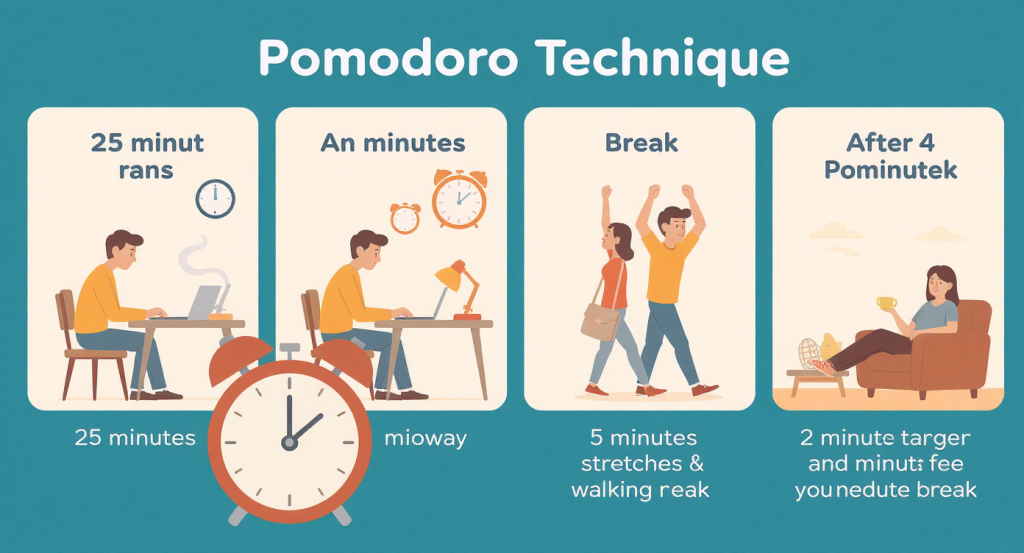The Pomodoro Technique is one of the most influential time management methods people use to maintain focus, stay more organized, and accomplish more. It was developed in the late 1980s by Francesco Cirillo, a university student in Italy, who struggled to stay focused while studying. Cirillo struck gold with a simple kitchen timer in the shape of a tomato (in Italian, pomodoro) to divide his work into timed intervals. He called these intervals “Pomodoros,” and the small experiment evolved into one of the most popular and effective productivity techniques worldwide.
At its core, the Pomodoro Technique is designed to help people work with time instead of struggling against it. Rather than plowing through hours of work at a time, which often leads to burnout, it breaks work up into short, focused bursts. It doesn’t just allow for maintaining high levels of focusing; it also hinders procrastination proclivities. Used regularly, this can help you accomplish more in less time, all while feeling relaxed.
The Origins and Inspiration Behind the Technique
Francesco Cirillo, a college student in the 1980s, first experimented with time management. He felt like he was wasting too much time and not learning efficiently. One day, he grabbed an hourglass-shaped kitchen timer in the form of a tomato and vowed to work for only 10 minutes. The pedestrian was shocked by how nimble and skilled he was at playing. Finally, he settled on 25-minute focused intervals, followed by brief breaks. This simple technique was a game-changer, and he soon shared it with the world via his book The Pomodoro Technique, where he explained his philosophy and principles in greater detail.
What Cirillo found, interestingly, is that when structured well, time pressure can be your friend. Rather than the time being used to measure progress and resource investment, the time became a visible entity. With work broken into manageable chunks, the Pomodoro Technique created a tension where a pressure for structure and time managed (what must be done in this block?) met with enough breaks for the mind not to fatigue. It was an innovative reset to think of time in terms of what it can give rather than what it takes away from our work.
How the Pomodoro Technique Works

Simple and flexible: The Pomodoro Technique is easy to understand and use. At the heart of the working methodology is the Pomodoro—a 25-minute intense burst of work during which you devote yourself to a single task without interruption. When the 25 minutes are over, you have a brief 5-minute break to rest and refresh. After four Pomodoros, you take a longer break, 15 to 30 minutes. These longer breaks are intended to allow your brain to rest truly, so that when you return to your duties, you feel refreshed.
You must remove all distractions during each Pomodoro. That might mean silencing your phone, closing down your surplus browser tabs, and making it clear to others that you’re not to be disturbed. If something comes up that’s going to interrupt you, you write it down and get back to work. This maintains the rhythm and reduces the chances of distraction. The rest is just as important as the work. They assist your brain in recovering, digesting what you’ve done, and preparing for your next cycle.
Psychological Principles Behind the Technique
One of the most significant psychological benefits of the Pomodoro Technique is its effective utilization of time pressure. Running against a time limit provides a motivating sense of urgency. This sense of urgency helps your brain transition into a flow state more quickly, a mental state in which you are entirely absorbed in your work. It also helps to mitigate the cycle of task switching, which can be one of the biggest drains on productivity and mental energy.
The Pomodoro Technique is also a method for harnessing the power of small wins. Each 25-minute session is a mini-goal, and crossing that off feels like an accomplishment. This feeling of progress is incredibly motivating and keeps you motivated to keep plugging away. Over time, they add up to a significant gain: increased productivity and greater confidence. Furthermore, the regular cycle of work and break helps to avoid burnout, a common problem in our high-stress society.
Benefits of the Pomodoro Technique
The Pomodoro Technique offers numerous benefits, particularly in a world full of distractions. Among the most amazing benefits of meth is enhanced attention. WHY IT WORKS When you’ve got just 25 minutes to focus on a task, you’re far more likely to dive in and pay attention to it. This ultimately results in higher quality work and less time wasted.
Another plus is decreased mental wear. Many austerity habits are characterized by long periods of unbroken use, which can be energetically depleting and cause burnout. With natural pauses built into your day, the Pomodoro Technique helps keep your mind fresh and sharp. This is not only more sustainable over time, but it also helps you to engage with complex or creative tasks.
It also promotes better planning and task estimation. Because each Pomodoro is time-bound, you become more aware of how long your tasks take. Over the years, this helps you calculate your days more effectively and set more realistic goals, so you don’t overbook yourself. It also makes progress visible, which can be motivating if you’re working on long-term projects.
Who Can Benefit from the Pomodoro Technique?

The greatest strength of the Pomodoro Technique is its flexibility. It’s also handy for students who want to study more effectively, professionals struggling with a heavy workload, and writers hoping to avoid procrastination or keep their kids on top of household tasks. It’s easy and flexible, allowing almost anyone to benefit from incorporating it into their daily routine.
Remote workers and freelancers, I particularly appreciate it. From work habits that separate work from the rest of your life. “The Pomodoro Technique is a way to add discipline and challenge to your workday. The method can also be a game-changer for people with attention issues, like ADHD, enabling them to break tasks down into bite-sized pieces and not feel so overwhelmed.
Tools and Apps to Support the Pomodoro Technique

To start using the Pomodoro Technique, all you need is a cooking timer or stopwatch; however, there are several digital tools available to assist you in implementing it more easily. Apps designed specifically for the Pomodoro technique (like Focus Booster, Pomodone, and Be Focused) will help you keep track of your time, drag-and-drop tasks into a schedule, and track your productivity over time. Many of these apps also integrate with other productivity tools, such as Trello, Asana, or Todoist, making it easy to fit them into your existing workflow.
Browser extensions, such as Marinara Timer or TomatoTimer, are also extremely convenient at work. Some tools also provide analytics that can help you see how you’re spending your time, which tasks take you the longest, and how many Pomodoros you work through every day. Whether you’re reaching for pen and paper or a digital to-do list, there are options to fit every type of worker.
Adjusting the Technique to Fit Your Needs
While the traditional Pomodoro clock recommends 25-minute work sessions followed by five-minute breaks, it’s fine to adjust these lengths to accommodate your working rhythm. Some prefer 50-minute work sessions and 10-minute breaks, but shorter durations, even 15 or 20 minutes, especially at first, may be more feasible for certain people.
The trick is to tune in to your own energy waves. If you notice that your mind starts to wander after 20 minutes, start there and work your way up. Likewise, if you are in the middle of a very engaging project and really don’t want to stop after 25 minutes, by all means, continue working, but be sure to take frequent breaks. The Pomodoro Technique is particularly flexible, which is a really useful feature; you should be able to bend Pomodoro to fit your life, not the other way round.
Common Challenges and How to Overcome Them
But, as with any new routine, the Pomodoro Technique is not without its challenges. Another common problem is to become disregarded in a Pomodoro. It’s also important that during these times you train yourself to resist the temptation to get on your phone or email. Have a notepad nearby to scribble thoughts that aren’t urgent so you can stay focused without losing your best ideas.
Another issue for me is the time pressure. Some may feel anxious with the clock ticking. If this occurs, try and remember that you are not aiming for perfection but progress. The intention of the Pomodoro Technique is to support you, not make you anxious.” It is also perfectly acceptable if you have to stop or restart a session. You’ll eventually establish your own pace and feel more at ease with the process.
Conclusion
In today’s world of relentless distractions, notifications, and time demands, the Pomodoro Technique provides a simple and pragmatic solution. It enables people to reclaim their attention, to more intentionally focus on work, and to feel more gratified at day’s end. It marries focus, structure, and rest, all in alignment with the way our brains actually work.
Whether you’re a student preparing for exams, a professional managing projects, or anyone who’s ever had more to do than you can handle, the Pomodoro Technique can help. It doesn’t take costly tools or the implementation of a complex system, just a timer, a task, and a willingness to stay focused. If you practice it regularly, this age-old technique can change how you work, how you think, and how you make your way closer to your goals.
